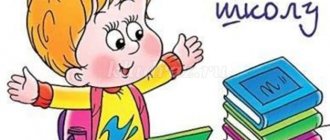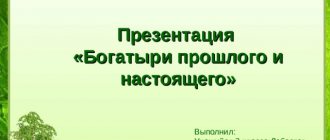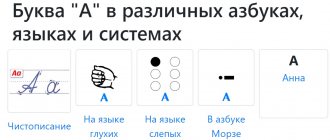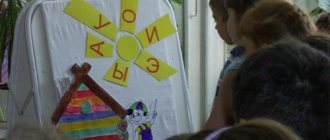Presentation for a node on teaching literacy in the preparatory speech therapy group “Sounds and the letter K”
Info lesson › Speech therapy › Presentations › Presentation for a node on teaching literacy in the preparatory speech therapy group “Sounds and the letter K”
Description of the presentation by individual slides:
1 slide Description of the slide:
Good morning!
Slide 2 Slide description:
My mood
3 Slide description:
This cat is the kindest in the world.
He always told the mice in his apartment that cats and mice needed to live together. 4 slide Description of slide: 5 slide Description of slide:
Vowel sounds
6 slide Description of slide:
Sounds consonant consonant consonant
7 slide Description of slide:
Finger game “Cat”.
Slide 8 Slide description:
Articulation gymnastics
Slide 9 Slide description:
Exercise “Smile”.
Smile 10 slide Description of slide:
Exercise “Punch the tongue”
11 slide Description of slide:
Exercise “Pancake”.
12 slide Description of slide:
Exercise “Pussy is angry
13 slide Description of slide:
Exercise “Brushing the lower teeth”
14 slide Description of slide:
Breathing exercises
15 slide Description of slide: 16 slide Description of slide: 17 slide Description of slide:
Characteristics: sound [K] - hard voiceless consonant.
Features of articulation: the tip of the tongue moves slightly away from the lower teeth, the back of the tongue is curved steeply and touches the palate. Under the pressure of exhaled air, the back of the tongue comes off the palate. The vocal cords are resting, the throat is not trembling (no voice). Slide 18 Slide description:
Color designation: green.
Characteristics: sound [K'] is a soft, voiceless consonant. Features of articulation: the tip of the tongue is pressed against the lower teeth, the back of the tongue is curved steeply and touches the palate. Under the pressure of exhaled air, the back of the tongue comes off the palate. The vocal cords are resting, the throat is not trembling (no voice). 19 slide Description of the slide:
Characteristics of the sound K and K'
20 slide Description of the slide: 21 slide Description of the slide:
Among the sounds: a, k, p, i, k, r, g Among the syllables: po, kya, ve, ku, ki, me
22 slide Slide description:
Pure sayings: ka, ka, ka - white flour ku, ku, ku - squirrel on a bitch ki, ki, ki - here come the bulls
23 slide Description of slide: 24 slide Description of slide:
Game “Find the picture, name which begins with the sound K".
(place of sound in a word) 25 slide Description of slide: 26 slide Description of slide:
Game “Find a picture whose name begins with the sound K'.”
27 slide Description of the slide: 28 slide Description of the slide:
Game “Fourth extra”
29th slide Description of the slide:
Cat is a pet
30th slide Description of the slide:
Game “Fourth odd”.
Slide 31 Slide description:
Pumpkin is a vegetable.
32 slide Description of slide: 33 slide Description of slide: 34 slide Description of slide:
Ko ok ku uk ka ak kak kok
35 slide Description of slide:
AND THE CAT
36 slide Description of slide: 37 slide Description of slide:
Like a beautiful picture Weaved a big web Neither a mosquito nor bug, And skillful...
38 slide Description of slide: 39 slide Description of slide:
SPIDER
40 slide Description of slide:
SPIDER
41 slide Description of slide:
SPIDER
42 slide Description of slide:
SPIDER
43 slide Description of slide:
SPIDER
44 slide Description of slide: 45 slide Description of slide: 46 slide Description of slide:
Characteristics of the sound K and K'
47 slide Description of slide:
My mood
48 slide Description of slide:
Find material for any lesson, indicating your subject (category), class, textbook and topic:
Select a category: All categoriesAlgebraEnglishAstronomyBiologyGeneral historyGeographyGeometryDirector, head teacherAdditional educationPreschool educationNatural scienceArt, Moscow Art Foreign languagesInformaticsHistory of RussiaClass teacherCorrectional educationLiteratureLiterary readingSpeech therapyMathematicsMusicPrimary classesGerman languageLifestyleSocial studiesEnvironmental studiesNatural studiesReligious studiesRussian languageSocial educatorTechnologyUkrainian languagePhysicsPhysical educationPhilosophyFran Tsuz languageChemistryDrawingSchool psychologistEcologyOther
Select a grade: All grades Preschoolers 1st grade 2nd grade 3rd grade 4th grade 5th grade 6th grade 7th grade 8th grade 9th grade 10th grade 11th grade
Select textbook: All textbooks
Select a topic: All topics
You can also select the type of material:
general information
Material number: DB-721802
ATTENTION TO ALL TEACHERS: according to Federal Law N273-FZ “On Education in the Russian Federation,” pedagogical activity requires the teacher to have a system of special knowledge in the field of teaching and raising children with disabilities. Therefore, it is important for all teachers to improve their qualifications in this area!
Distance course “Students with disabilities: Features of organizing educational activities in accordance with the Federal State Educational Standard”
from the “Infour Lesson” project gives you the opportunity to bring your knowledge into compliance with the requirements of the law and receive a certificate of advanced training in the established form (72 hours).
Apply for a course
Similar materials
You might be interested in these courses:
Leave your comment
infourok.ru
Presentation “Preparing preschool children for learning to read and write.” Presentation on learning to read and write on the topic
Slide 1
Preparing preschoolers for literacy. Prepared and conducted by teacher-speech therapist of MDOU “Kindergarten No. 50” Makarycheva N.V.
Slide 2
What is literacy? Literacy is the ability to read and write. Reading and writing are types of speech activity, the basis for which is oral speech. Consequently, the basis for teaching literacy is the general speech development of children. In modern methodology, the sound analytical-synthetic method of teaching literacy has been adopted. Its very name suggests that training is based on analysis and synthesis of the sound side of speech. This method is based on the positional principle of reading, i.e. the pronunciation of a consonant phoneme when reading should be carried out taking into account the position of the vowel phoneme following it. For example, in the words small, chalk, crumpled, soap, mule, the consonant sound is pronounced differently each time depending on what sound follows it. When teaching literacy, this is manifested in the fact that students must: clearly distinguish all vowel and consonant phonemes; find vowel phonemes in words; focus on the vowel phoneme and determine the hardness or softness of the preceding consonant phoneme; acquire consonant phonemes in combination with all vowels. At preschool age, children must acquire a broad understanding of the sound aspect of speech. The development of phonemic perception, the formation of a broad orientation of children in the language system, the skills of sound analysis and synthesis, as well as the development of a conscious attitude towards language and speech constitute one of the main tasks of special preparation of children for learning to read and write.
Slide 3
Preparing for literacy in different age groups. Program analysis. Junior group Middle group Senior group Teach children to clearly pronounce vowels in words (a, u, i, o, e) and some consonant sounds p-b-t-d-k-g; f-v; t-s-z-ts. Develop motor skills of the speech-motor apparatus, auditory perception, speech hearing and speech breathing, clarify and consolidate the articulation of sounds. Develop the correct speech rate and intonation expressiveness. Learn to clearly pronounce words and short phrases, speak calmly, with natural intonations, consolidate the correct pronunciation of vowels and consonants, practice the pronunciation of whistling, hissing and sonorant (r, l) sounds. Develop the articulatory apparatus. Continue to work on diction: improve the clear pronunciation of words and phrases. Develop phonemic awareness: learn to distinguish by ear and name words that begin with a certain sound. Strengthen the correct, distinct pronunciation of sounds. Learn to distinguish by ear and clearly pronounce consonant sounds similar in articulation and sound: s-z, s-ts, sh-zh, ch-ts, s-sh, zh-z, l-r. Continue to develop phonemic awareness. Learn to determine the place of a sound in a word (beginning, middle, end). Practice intonation expressiveness of speech.
Slide 4
Preparatory group Sound culture of speech Preparation for learning to read and write To improve the ability to distinguish by ear and pronunciation all the sounds of the native language. Practice diction: teach children to clearly and distinctly pronounce words and phrases with natural intonations. Improve phonemic awareness: learn to name words with a certain sound, find words with this sound in a sentence, determine the place of the sound in a word. Practice intonation expressiveness of speech Give ideas about the sentence (without grammatical definition). Practice composing sentences, dividing simple sentences (without conjunctions or prepositions) into words, indicating their sequence. Teach children to divide two- and three-syllable words with open syllables (na-sha Ma-sha, ma-li-na, be-re-za) into parts. Learn to form words from syllables (orally). Learn to identify the sequence of sounds in simple words.
Slide 5
Content of work on preparing children for learning to read and write When determining the content of work on preparing for learning to read and write, it is advisable to highlight the following areas: familiarizing children with the word - isolating the word as an independent semantic unit from the flow of speech; familiarization with a sentence - isolating it as a semantic unit from speech; familiarization with the verbal composition of a sentence - dividing a sentence into words and composing sentences from words (2-4); familiarization with the syllabic structure of a word - dividing words (of 2-3 syllables) into parts and composing words from syllables; familiarization with the sound structure of words, developing skills in sound analysis of words: determining the number, sequence of sounds (phonemes) and composing words with certain sounds, understanding the semantic and distinctive role of the phoneme. development of graphic skills. The leading role is played by the formation of the ability to analyze the sound composition of words.
Slide 6
Familiarization with the word When forming ideas about the word, two main points can be distinguished: isolating the word from the flow of speech and revealing the word as an independent semantic unit. Children begin to become familiar with the term “word” in the middle group in the process of communication, when performing various speech exercises to teach sound pronunciation and enrich the vocabulary. Expressions “Listen to me say this word”, “Say the word…. correctly" are often used by the teacher. In order to isolate words from the stream of speech, various game exercises are used in which children use words to name different objects and toys, their properties and qualities; means of fiction, with the help of those works in which the word plays a large role; games in which game actions are determined by words that can or cannot be pronounced: “Forfeits”, “Black and White”, “Telephone”, “Echo”, “Say the other way around”; vocabulary exercises, word formation exercises. They help to draw the child’s attention to the semantic side of the word (the word denotes an object, sign, action).
Slide 7
Familiarization with the sentence Familiarization begins with the analysis of simple sentences without prepositions and conjunctions, consisting of 2 - 3 words (The doll is sitting. The doll is holding a ball). To analyze sentences, visually effective methods and techniques are used: looking at toys, demonstrating actions with toys, looking at paintings, and spatial modeling. Work is underway to draw up proposals. The basis of training is the following: clear pronunciation of a sentence, highlighting words with a voice, their quantitative and ordinal counting (how many words, which is the first word, which comes next), spatial modeling of words using abstract symbols (lines, stripes, squares, etc.). This helps the child understand linearity (sequence) and discreteness (articulateness) of speech. It is advisable to use diagrams. Children are explained that a sentence can be drawn (written down) to find out how many words it contains. The teacher draws lines on the board according to the number of words in the sentence being analyzed: “One line means one word. There are three lines here, which means there are three words in the sentence. The first word is indicated not by a simple line, but by a line with a corner, and a period is placed at the end of the sentence.” Techniques: clear pronunciation of words with a pause; pronouncing words accompanied by clapping (by the teacher, individual children, the whole group); sequential naming of words in a sentence; counting words in a sentence on your fingers using counting sticks; in loud speech, to oneself; variants of the game “Living Words”; pronouncing words randomly; pronouncing words in rows; whispered analysis of a sentence; composing sentences from different numbers of words; composing sentences with a given word; making sentences based on a “live scene” (Sasha is fishing. Sasha is a fisherman), jumping rope, tapping on a drum or tambourine as many times as there are words in the sentence.
Slide 8
Familiarization with the syllabic structure of a word A syllable is a pronunciation and word-forming unit of speech. At the initial stage of work, two-syllable words are taken for analysis, consisting of direct open syllables, the pronunciation and spelling of which are the same (Masha, fox). Gradually, words consisting of three parts (ma-li-na, kar-ti-na) are introduced for analysis, and only then monosyllabic words (cheese, house), since they cannot demonstrate what part of a word is.. Techniques: quantitative and the ordinal count of syllables in a word; counting the touches of the back of the hand to the chin when pronouncing a word; a schematic representation of the syllabic composition of a word (as when familiarizing yourself with the composition of a sentence); speech game “Living Syllables” (similar to the game “Living Words”); pronouncing a word syllable by syllable, matching it with a diagram; selection of words with a given number of syllables (based on toys, surrounding objects, paintings, according to diagrams, according to verbal tasks); selection of words with a given syllable (ma, li, lu), addition of a syllable to a complete word; “transformation” of short words into long ones and vice versa, corresponding changes in the schemes of the syllabic structure of the word (fox, fox, little fox), intentional mistakes of the teacher when syllabically pronouncing words in the process of working with the scheme and correction of errors by children with the corresponding conclusions; rearrangement of syllables in a word (transformation of words): mouse - reed, bank - boar; a variety of gaming techniques: “Who will quickly see objects whose names have two (three) syllables”; asking riddles about objects whose names have a certain number of syllables; “How the bear learned to speak” - the bear teaches the bear to pronounce words in parts; “Toy store” - the seller gives a toy to the buyer if he correctly pronounces its name in syllables; “Feed the animal” - children name words denoting food items and consisting of a different number of syllables; “Who will live in which house” - insects live in square houses, the names of which have one, two, three syllables.
Slide 9
Familiarization with the sound structure of a word Let's remember: We hear and pronounce sounds. We see and write letters. A letter is a graphic symbol of sound. Vowel sounds are sounds during the pronunciation of which the air stream comes out freely, neither lips, nor teeth, nor tongue interfere with it, therefore vowel sounds can sing. They pronounce with a voice (voice, say), and can sing any melody. We decided that vowel sounds would only live in red houses (red circles or squares). Consonant sounds are sounds during which the air stream encounters an obstacle. It is either her lips, teeth, or tongue that prevent her from coming out freely. Some of them can be pulled off (SSS, MMM,) but none of them can sing, but they want to sing. Therefore, they AGREE to be friends with vowels, with which they can also sing any melody (ma-ma-ma -...). That's why these sounds were called CONSONANT sounds. Hard consonant sounds [P, B, T, D, M, K, G, ...] - blue circles or squares sound angrily (hard) in words. Soft consonant sounds [ПП-П', ББ-Б', Т-Т', Дь-Д', МБ-М'...] - green circles or squares sound affectionately (softly) in words. The sounds [Ш, Ж, Ц] are always hard, they do not have a “soft” pair (no “gentle” brothers). The sounds [Ch, Shch, Y] are always soft, they do not have a “hard” pair (there are no “angry brothers”).
Slide 10
Sound analysis and synthesis. To solve the problem of preparing children for sound analysis, it is necessary to teach them to perceive a word not as a single sound complex, but to teach them to hear individual sounds in a word. The way to highlight a sound in a word is to pronounce the word in a special way - with intonation, especially emphasizing one sound in it. The child needs to be specially taught a special drawn-out pronunciation of the sound, its intonation emphasis (OOOlya, aaarmelon, shshshapka, sssobaka). In this case, articulation begins to play a special role, performing the function of orientation in the word. Mastering the method of intonation sound selection is helped by the techniques of comparing speech sounds with the “songs” of the wind - shshsh, pump - sss, their pronunciation, and detecting the sound (“songs”) in words spoken by adults (with intonational emphasis of sound). They select words that can be pronounced drawn out (with hissing, sonorant consonants). Next, children are asked to name pictures and toys so that the “song” of the wind can be heard: shshshar, catshshka, pencilshsh; “song” of a beetle - zhzhbuk, scissors. Gradually, instead of the word song, the word sound begins to be used. The ability to pronounce words with sound intonation is reinforced in the game tasks “Say it like me”, “Say it so that everyone can hear the sound s in the word butter”.
Slide 11
When children have mastered the method of intonation highlighting a sound in a word, they begin to be taught to determine where the desired sound is located - at the beginning, middle or end of the word. At the beginning of learning, children can be offered animal figures, where the animal's head indicates the beginning, the body indicates the middle, and the tail indicates the end of the word. Children put the symbol of the identifiable sound in the correct square. It is recommended to start getting acquainted with consonant sounds with the sounds [m], [n], because: Articulation is very sharply different from the articulation of vowel sounds; the air encounters an obstacle. It is these sounds that will make it easier for children to learn the merging process necessary for the skill of syllabic reading. When getting acquainted with each sound, its full characteristics are given, based on tactile, visual, auditory, and motor analyzers. Children learn that sound can be heard, articulation seen, and felt. For intonational emphasis, children are offered not only hard consonant sounds, but also soft ones: pppetukh (p'), kkkit (k'). The explanation of the softness and hardness of sounds is given in a playful way: paired phonemes (m - m ', s - s ') are called “brothers”; hard ones are “angry”, soft ones are “kind”.
Slide 12
At the first stage, children are taught to determine the order and sequence of phonemes. For this purpose, not only the method of intonation highlighting sounds that they have already mastered is used. Preschoolers cannot, relying only on pronunciation, establish the order of sounds. Therefore, D.B. Elkonin proposed modeling the structure of a word in the form of a picture diagram of its sound composition. The picture depicts an object, the word-name of which must be analyzed. Below the picture is a graphic diagram of the sound composition, which is a horizontal row of cells according to the number of phonemes. It should be especially emphasized that these complex forms of modeling can be moved on only if children have learned to distinguish sounds intonationally and, on the basis of this, determine their place in a word.
Slide 13
Sound analysis goes through the following stages in its formation: intonational identification of a sequence of phonemes and general phonemic analysis of a word based on a picture diagram and chips; differentiation of vowel and consonant phonemes; differentiation of consonant phonemes by hardness and softness (hereinafter - by deafness and voicedness) and modeling of basic phonemic relationships in a word; conducting sound analysis without relying on clarity - a graphical diagram, and then gradually abandoning the chips. Complete sound analysis is carried out in the mind (internally).
Slide 14
Development of graphic skills Writing, like reading, is impossible without a high level of development of oral speech, which is the basis for their formation, its awareness and analysis, as well as without the development of a general ability for analytical and synthetic activity. Another aspect of preparing for writing is directly related to mastering writing techniques, the motor side of graphic skills, and the formation of psychomotor readiness for writing. The initial stage of mastering the skill of writing is very difficult for children; it requires the development of smooth, rhythmic, well-coordinated movements of the hand, fine spatial orientation, and a good eye. These difficulties are overcome through long, systematic exercises. Tasks of preparing the hand and eye for writing in the preparatory group: 1. Development of the accuracy of visual perception, the formation of the ability to isolate elements from the whole and re-combine them into a whole, the development of the accuracy of spatial differentiation. 2. Development of orientation in space in directions (right, left, right side, left side, box). 3. Familiarization with the rules of writing: write from left to right; sequentially fill the page, maintaining the same size of elements and equal distance between them. 4. Preparing the small muscles of the hand for writing and developing the ability to control one’s movements in accordance with the task (hatching, drawing borders) 5. Developing the ability to accompany one’s observations and actions with verbal explanations. 6. Training in compliance with certain hygienic requirements when performing preparatory exercises for writing (location of the notebook, sitting at the table, posture of the writer, distance of the eyes from the notebook, rules for holding a pen, pencil). It is advisable to carry out specially selected preparatory exercises: outlining and shading geometric shapes, contour images of vegetables, fruits, mushrooms, leaves; drawing objects that resemble elements of letters (flags, circles, cucumber, fishing rod, etc.) During these exercises, attention is paid to the development of the eye and accuracy of visual perception, spatial orientation on a sheet of notebook, and compliance with hygienic rules when writing.
Slide 15
Thank you for your attention.
Literacy - Early Childhood Education
The work program “Preschoolers” for preparing children 6-7 years old for school was developed in accordance with the requirements of the Federal State Standard of Primary General Education of the second generation, based on the program “Continuity” (a program for preparing children 5-7 years old for school) scientific.
hands N. A. Fedosova (M.: Prosveshchenie, 2012), recommended by the Ministry of Education of the Russian Federation. The program prepares children for school, providing continuity between preschool and primary general education.
The goal of the program is the successful adaptation of preschool children to new educational conditions and the creation of conditions for a humane (comfortable) transition from one educational level to another.
Preparing children for school occupies a special place in the education system. This is due to the child’s difficult adaptation to school. The school places quite high demands on first-graders. A preschool child should be ready not only for new forms of communication. He must have a developed motivational sphere, where curiosity acts as the basis of cognitive activity, and the emotional-volitional and cognitive spheres of mental functions have been formed. A future first-grader must have basic skills in universal learning activities (UAL), communicative and speech competencies.
The development of a child’s potential through mastering the educational skills proposed by the federal standards for primary general education forms the basis of primary education. In this regard, creating the prerequisites for schooling is another equally important goal of the program.
The “Preschool Children” program solves the problems of the general development of the future first-grader, his physical, social and psychological functions necessary for systematic learning at school.
Main objectives: maintaining and strengthening health; development of personal qualities; formation of value systems and orientations; development of creative activity; formation and development of mental functions of the cognitive sphere; development of the emotional-volitional sphere; development of communication skills; development of skills to act according to the rules.
pedsovet.su





